| ABSOLUTE AGE |
| DETERMINING ABSOLUTE AGE FROM THE ROCK RECORD |
| We have already discussed determining the relative ages of events. We will now discuss absolute age determination, which assigns a quantitative estimate of the number of years ago an event occurred.
|
|
SIMPLE COUNTING
|
|
For a series of horizontal, depositional layers that are not overturned, the relative age of each layer with respect to the other layers may be known by invoking the Law of Superposition: the material on which any layer is deposited is older than the layer itself. Thus, in a series, the layers are successively younger, going from bottom to top. What may not be known is how long ago in years (or some other unit or units of time) any of the layers formed (their absolute ages). |
| In some circumstances, the absolute age may be readily determined. Consider a flat-floored valley in which a river flows. On April 1, 2005 the river flooded (diagram A). When the flood waters receded on May 1, 2005, it was seen that a layer of sediment (layer 'f') had been deposited on the valley floor (diagram B). Next year, on April 1, 2006, the river flooded again, covering the valley floor. And once again, when the flood waters receded on May 1, 2006, it was seen that another layer of sediment (layer 'g') had been deposited on the valley flood (diagram D). The flooding and deposition have occurred through the years on an annual basis, gradually filling the valley with a stack of layers (a through g). A pottery bowl was incorporated into the sediment at location X when layer 'c' was being deposited. On May 1, 2006 a farmer drilling a well discovers the pottery bowl. To calculate how many years ago the bowl was buried, the farmer counted the number of layers from the surface down to the layer in which the bowl was incorporated. The bowl is in the 5th layer beneath the surface. Knowing that the depositional cycle is one layer per year, the farmer calculates that the bowl was buried four cycles before the most recent layer was formed. Since the most recent layer formed 0 years ago, the burial took place 0 years + (4 times 1 year) ago = 4 years ago. If the farmer had waited until October 1, 2006 to do the calculation, the time of the burial would have been 0.5 years plus (4 times 1 year) ago = 4.5 years ago.
The formula for calculating absolute age of a layer by this method of counting is:
Absolute age in years (A) = time elapsed since the formation of the most recent layer (R) plus (the number of layers (N) lying above the layer in question multiplied by the duration (D) of the depositional cycle).
A = R + (N x D)
This method assumes that the duration of the cycle is a constant.
If the duration of the cycle is not a constant, but durations of individual cycles do not vary very much, the average duration of the cycle may be used without losing much accuracy. |
A - April 1, 2005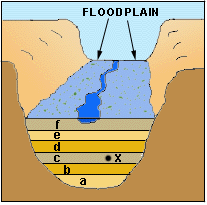 B - May 1, 2005
B - May 1, 2005 C - April 1, 2006
C - April 1, 2006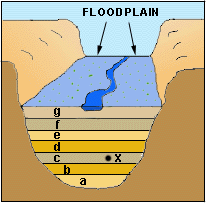 D - May 1, 2006
D - May 1, 2006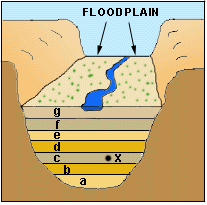 |
This simple counting method has been famously used for dating artifacts buried in the floodplain deposits of the Nile River. Before the completion of the Aswan High Dam in 1970, a new layer of soil was deposited every year during annual flooding. To determine the age (within one year) of any layer, all that needed to be done was to count the number of layers down to the artifact and that was equal to the absolute age of the artifact's burial.

Photo by NASA
Since the building of the Aswan Dam in 1970, flooding and deposition of soil in the Nile downstream have ceased. To get the age of the burial of an artifact, therefore, the time elapsed since 1970 has to be added to the number of layers. (In 2006, 36 years would have to be added.) (In actuality, the Aswan Dam was built in several stages, starting in 1889, so the interval between deposition of the uppermost layers is actually irregular, voiding simple application of the formula.) 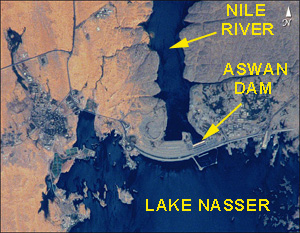
Photo by NASA
|
|
SIMPLE COUNTING PLUS PATTERN MATCH
|
|
In areas with glaciers, the ice undergoes melting every spring and summer. The meltwaters carry away sediment that was trapped in the ice. Where the sediment-laden meltwaters flow into a lake, a layer of sediment is deposited on the lake floor every year. Coarse sediment is deposited quickly; fine sediment remains suspended in the water until it has a chance to gradually settle out during the cold months when the surface of the lake is frozen over and the water is quiet. Each annual layer, therefore, has two parts: a thick coarse sandy layer overlain by a thinner, fine clayey layer. The coarse-fine couplet is known as a varve ('varv' is Swedish for 'layer'). If the process of annual varve deposition continues today or only ceased in historic time, and the date of cessation was recorded, then simple counting can reveal the absolute age of any layer within the lake basin, using the formula developed above:
A = R + (N x D).
|
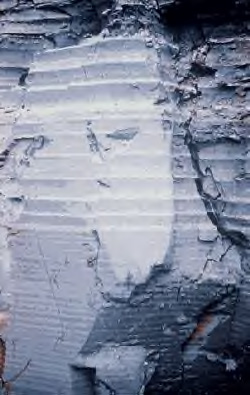
VARVES
Courtesy Natural Resources Canada
(Geological Survey of Canada, photo number kgs156) |
| However, deposition of varves may cease because the glaciers have melted away completely or because the lake basin has been completely filled by sediment. If annual deposits ceased before human records dating the event were kept, then the length of time that has elapsed since the top layer was deposited must be determined in some other fashion. Correlation of time-equivalent layers may be accomplished by 'pattern matching'.
It has been observed that in any given year, varve thicknesses vary from places to place. This is not surprising, since different meltwater streams carry different sediment loads. Also, in any given place varve thicknesses vary from year to year, being thicker when temperatures are higher and meltwaters are more voluminous and flow faster, and thinner when temperatures are lower and stream volume and velocity are diminished. Such yearly changes in stream volume and velocity and thickness of depositional layers tend to be regional: the volume and velocity of all streams being dependent upon regional weather patterns. Throughout the region, all layer thicknesses may be double what they were the year before. Through time, therefore, although layer thicknesses vary from place to place, the ratio of layer thicknesses to each other at one site are the same as the ratio of layer thicknesses to each other at a different site.
|
|
The diagram on the right shows varves that accumulated simultaneously during the same 8-year time interval at locations A, B, and C. Note that although the thicknesses vary from location to location, the ratios of thicknesses remain constant. At location A, from oldest to youngest, the thicknesses for the layers are 0.5", 0.15", 0.3", 0.4", 0.1", 10.0", 0.2" and 0.5 ". The ratio of the thicknesses is 5:15:3:4:1:10:2:5. At location B, the layer thicknesses are 75% of those at location A, but the ratio remains 5:15:3:4:1:10:2:5. Similarly, at location C, the thicknesses are 50% of those at A, but the ratio remains constant. That is, the pattern is the same at at the three locations. It is important to note that the pattern is random. The position within the series of any layer, therefore, is unique. Layers formed at the same time, such as layer 'X', may be recognized. That is, equivalent layers may be correlated.
| 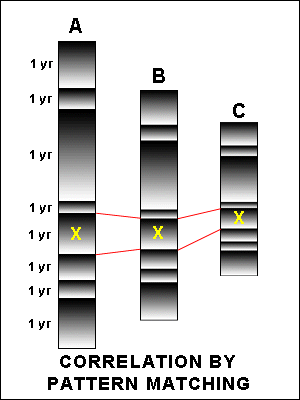 |
|
Correlation using pattern matching makes it possible to determine, in a location where deposition has ceased, the absolute ages of the layers. This is accomplished by comparison with a location where annual deposition continues.
Consider the varve sequences at locations A, B and C. At A, yearly deposition continues, so the absolute ages of layers can be determined by counting down from the top. At locations B and C, deposition stopped at some time in the past. Indeed, some of the top layers may have been removed by erosion. However, by pattern matching, five layers within the series at A can be correlated with five layers at the top of B.
Similarly, by pattern matching, five layers in the series at B can be correlated with five layers at the top of C.
Since the ages of the layers at A are known by counting down from the top, layers at B that correlate with them can also be assigned ages. Then, the ages of the rest of the layers at B may be determined by counting down. In similar fashion, layers at C that correlate with layers at B may be assigned ages, and the rest of the layers at C may be assigned by counting down.
Using this method, ages of varves that formed tens of thousands of years ago may be determined. For example, varves close to forty thousand years old have been dated in Japan.
Pattern matching is also used to date trees by examining growth rings (dendrochronology). Ages up to 14,000 years have been determined in this fashion. | 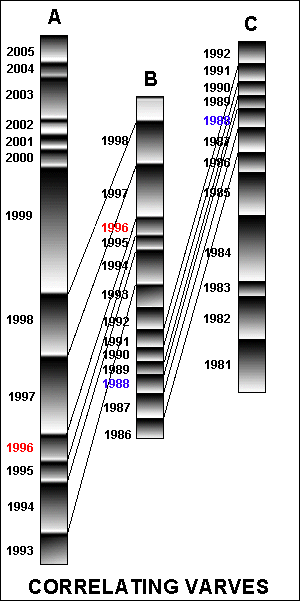 |
|
QUIZ: DETERMINING ABSOLUTE AGE BY PATTERN MATCH
|
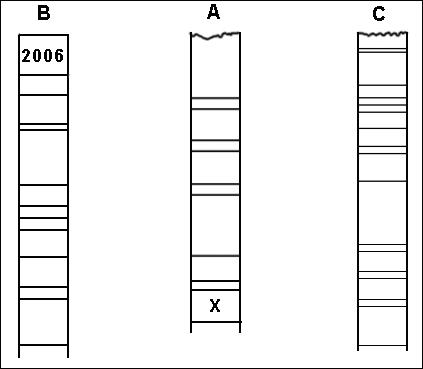
An archeologist finds a dried out, abandoned flood plain at location 'A'. He drills a hole and extracts a drill core that shows a series of layers of sediment one of which contains pottery fragment 'X'. The archeologist then contacts his colleague who is working in a nearby area (location 'B') where there is a modern floodplain to which a layer of sediment is added every year. He asks his colleague to extract and send him a drill core from location 'B', making sure to include and label the most recent layer, deposited in 2006. She does so, and also includes another drill core from a third location 'C', where she has recently worked. She tells him that location 'C', like location 'A', is also a dried out, abandoned floodplain. The first archeologist wants to know in what year the layer containing pottery fragment 'X' was deposited.
 Question 1: In what year was the layer formed that contains pottery fragment 'X'? Question 1: In what year was the layer formed that contains pottery fragment 'X'?
|
|
|
RADIOMETRIC DATING
|
|
'Simple counting' and 'pattern match' methods of determining absolute age have as their advantage that, with proper precautions, they can provide accurate ages without the use of sophisticated technology. Indeed, dating of lake sediments using varves was undertaken as early as 1879.
Their disadvantage is that they are restricted to sites where annual deposition has occurred and the absolute age of at least one layer can be determined with confidence by some other means (for example, by counting or by pattern matching with places where annual deposition continues through to today). Places satisfying these requirements are relatively few. Another disadvantage is that over geologic time, preservation of such layers is limited. Absolute age determination by varve counting is only suitable for materials less than several tens of thousands of years old.
These limitations are overcome in radiometric dating. Radioactive elements, such as certain isotopes of uranium, thorium, rubidium, potassium, carbon and others, have the property that over set periods of time, known as their 'half lives' (which are different for each radioactive element), half of their atoms decay to form atoms of different elements. For example, over the course of 704 million years, half the atoms of the 'parent' element uranium-235 (U-235) decay to form atoms of the 'daughter' element lead-207 (Pb-207). Over the next 704 million years, half of the remaining U-235 atoms change to Pb-207, and so on. By comparing the ratios of U-235 to Pb-207 that are found in the material today, the time when the process started may be ascertained (see table below).
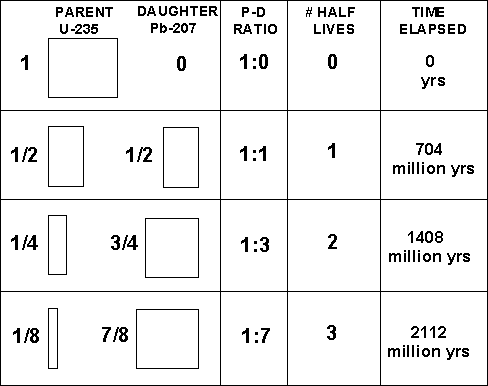
Examples of radioactive parent-daughter pairs and their half lives include:
- U-238 - Pb-206 (4.5 billion years)
- U-235-Pb-207 (704 million years)
- Rb-87 - Sr-87 (48.8 billion years)
- K-40 - A-40 (1.25 billion years)
- C-14 - N-14 (5730 years)
The error for radiometric dating is typically about 1 % or less. Thus, for a material whose age is determined to be 2 billion years old, the error may be on the order of plus/minus 20 million years. An error of that magnitude may be quite acceptable for such old rocks. |
|
QUIZ: RADIOMETRIC DATING
|
|
After careful analysis, a geochronologist determines that an unweathered, unmetamorphosed mineral sample contains 7 trillion atoms of the radioactive element K-40 and 105 trillion atoms of its decay product A-40.
 Question 1: How many years ago was the sample formed? Question 1: How many years ago was the sample formed?
|
|
It is important to choose a radioactive parent-daughter pair whose half life is appropriate for the age of the material being dated. - On the one hand, the half life should be short enough so that a measurable amount of the daughter element has formed.
- On the other hand, if the half life is too short, the amount of parent element left may not be measurable.
Thus, K-Ar dating would not be appropriate for a material that is 50,000 years old, as hardly any daughter element would have formed. Similarly, C-14 dating is not be appropriate for materials older than about 70,000 years as the amount of the parent element left becomes too small to be measured accurately.
|
Radiometric dating depends on certain assumptions. - The most fundamental assumption is that the half life of a parent-daughter pair does not change through time. Experimentally and theoretically, that assumption seems justified. Also, successful cross-checking of ages using different dating techniques on the same sample supports the constancy of half lives. For example, C-14 dates may be checked against ages determined through varve counting.
- A second assumption is that the system is closed. That is, no parent or daughter material has been added to or lost from the material being dated. Such addition or subtraction may occur if the material (mineral or rock) has been weathered or metamorphosed. Therefore, material to be dated must be carefully examined to determine whether such processes may have taken place.
- Because the dating method depends upon comparing the ratio of parent to daughter element, the assumption must be made that the amount of daughter element initially present be zero or else be determinable.
Igneous rocks and highly metamorphosed rocks are the best candidates for radiometric dating because for them, for reasons that won't be discussed here, it can relatively easily be determined whether the initial amount of daughter element present was zero or, if it wasn't zero, what was the initial amount.
Igneous Rocks: The 'age' of an igneous rock refers to the time when the magma or lava from which it formed cooled below a certain temperature. A useful material for dating that time is the mineral zircon, a minor but common constituent of igneous rocks. As magma or lava solidifies, the elements zirconium (Zr), silicon (Si) and oxygen (O) link together to form zircon crystals. If uranium (U) atoms are in the vicinity, they may be incorporated into the zircon in place of Zr atoms. This substitution is possible because the size and charge of the U is similar to that of Zr. That is, the U can 'fit' in the sites normally occupied by Zr.
Any lead (Pb) in the vicinity cannot be incorporated in the zircon because it can't 'fit' in any of the sites. Assuming the zircon has not been affected by weathering or metamorphism, any Pb subsequently found in the zircon must have come from decay of the U; it was not there to start with. Determination of the Pb-207/U-235 ratio in the zircons gives their age and thus the age of the igneous rock in which they occur. (It is true that not all minerals that crystallize from a magma or lava form simultaneously, but except for extremely young igneous rocks, the time required for solidification is very short compared compared to the age of the rock.)
Metamorphic Rocks: Accurate radiometric dating of metamorphic rocks is more difficult. During metamorphism, preexisting minerals may be altered and new minerals may be formed. For preexisting minerals, there is the distinct possibility that during metamorphism, parent or daughter elements may have been added or lost. If this happens, attempts to determine an accurate original (premetamorphic) age of the material will be frustrated. For example, loss of some of the daughter element will give a deceptively young age; addition of daughter element will give a deceptively old age.
However, if the rock is highly metamorphosed, the situation is more propitious. For example, in the K-Ar system, all of the daughter element (Ar) may be lost from some preexisting minerals. Or else, completely new mineral grains may develop that contain the parent element (K) but totally lack the daughter element (Ar). In either case, these minerals constitute new 'closed' systems with zero initial daughter element and, if dated, give the age of the metamorphic event.
Sedimentary Rocks: The age of a sedimentary rock refers to the time when loose sediment is turned into rock (becomes 'lithified'). Sedimentary rocks are varied and complex, but for many of them, the sedimentary particles out of which they are made consist of material eroded from prexisting rocks. After transportation and deposition, the particles are bound together in some fashion, perhaps by a 'cement'. Those processes do not reset the clock: that is, change the ratio of isotopes inherited from the parent rock. Thus, if the particles are dated, the ages obtained refer to the ages of the rock from which they were derived. In consequence, for many sedimentary rocks, the constitutent grains have widely varying ages. To get the age of the sedimentary rock itself, the material dated has to have formed at the time of consolidation of the rock. For most sedimentary rocks, there is no such material that is datable (contains suitable parent-daughter elements). Sedimentary rocks must, therefore, be dated by 'bracketing'.
|
|
BRACKETING
|
| 'Bracketing' is an indirect way of finding approximate age for an object whose relative age is known but whose absolute age can't be determined directly. The method involves determining the absolute ages of slightly younger and slightly older objects to set limits within which the unknown age must lie. Consider this example: You know that Agnes is a 'middle child', younger than her sister Mary, who has just turned 7, and older than her brother John, who is 4 and about to celebrate his 5th birthday. With this knowledge, you have Agnes' age 'bracketed'. Agnes is more than 4 and less than 7 years old. |  |
| Sedimentary rocks whose absolute ages can't be determined directly may be established by dating associated lava flows. In the example to the right, the numbered layers are sedimentary rocks. After deposition of layers 12 and 13, lava flow 'X' was erupted. Then, layers 14-16 were deposited, followed by eruption of lava flow 'Y'. Finally, layers 17 and 18 were deposited. Radiometric dating of the lava flows established their ages as 2 million years for 'Y' and 1 million years for 'X'.
Using the Law of Superposition: - Layers 12 and 13 must be older than 2 million years.
- Layers 14 to 16 must be younger than 2 million years but older than 1 million years.
- Layers 17 and 18 must be younger than one million years.
| 
Layers 12-13 > 2 MY
Layers 14-16 > 1 MY but < 2 MY
Layers 17-18 < 1 MY
|
| Ages of sedimentary layers may also be established by dating associated igneous intrusives. In the example to the right, after sedimentary layers 21 to 25 were deposited, lava flow 'Q' was erupted. Then, sedimentary layer 26 to 28 were deposited. At some time after the deposition of the first half of layer 27, igneous intrusive 'P' was emplaced. Radiometric dating of the lava flow and the intrusive established their ages as 5 million years for lava flow 'Q' and 2 million years for intrusive 'P'. Using the Law of Superposition:
- Because they are under the lava flow, layers 21-25 are older than 5 million years.
- Because they are above the lava flow, layers 26 to 28 are younger than 5 million years.
Using the Law of Cross-Cutting Relationships: - Because they are cut by the intrusive, layer 26 and 27 are older than 2 million years.
- Because it is not cut by the intrusive, it is not known whether layer 28 was deposited before or after the intrusive was emplaced. Its age can only be designated as less than 5 million years.
| 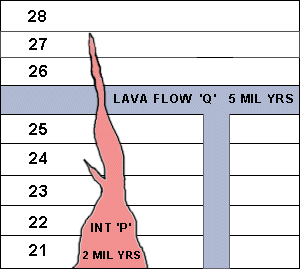
Layers 21-25 > 5 MY
Layers 26-27 > 2 MY but < 5 MY
Layer 28 < 5 MY
|
|
BRACKETING AND CORRELATION
|
| Sedimentary rocks in regions where there are no associated datable roks may have their absolute ages determined by correlating them with sedimentary rocks whose ages have been established by bracketing. In the example shown below, two of the layers at location 'X', 24 and 28, are fossiliferous, containing fossil assemblages B and A respectively. Their ages have been determined by bracketing: layer 28 is less than 5 millions old; layer 24 is more than 5 million years old.
At location 'Y', several thousand miles away from location 'X', a series of sedimentary layers and a lava flow ('L') are discovered. The age of the lava flow is radiometrically dated as 1 million years old. The sedimentary layer immediately above (colored pink) and and the one immediately below (colored green) the lava flow are found to have fossil assemblages 'A' and 'B', the same fossil assemblages as occur at location 'X' in layers 28 and 24, respectively. Therefore, the times of formation of Layer 28 and of the 'pink' layer fall within the same time span; that is, layer 28 and the 'pink' layer correlate with each other. Similarly, layer 24 and the 'green' layer correlate with each other.  Declaring this correlation or 'time equivalency' requires some justification. It has been observed that as life forms change through time, forms that become extinct never reappear at another time. Evolution, like history, is 'unidirectional'. Thus, to draw a parallel with history, if an event can be shown to have occurred at the same moment Lincoln was assassinated, that pins the event down in time, for Lincoln was only assassinated once.
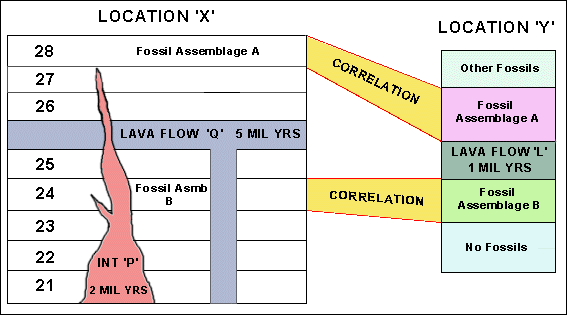
Because of these correlations, the ages determined for layers 24 and 28 may be applied to the 'green' and 'pink' layers, respectively: the 'green' layer is more than 5 million years old; the 'pink' layer is less than 5 million years old.
But the ages may be refined by referring to the age of lava flow 'L'. - Because the 'pink' layer lies above the lava flow, it is younger than the lava flow: less than 1 million years old. Since layer 28 correlates with the 'pink' layer, instead of saying layer 28 is less than 5 million years old, it now can be said to be less than 1 million years old.
- Because the 'green' layer lies under lava flow 'L' it is is older than the lava flow: more than 1 million years old. But because it correlates with layer 24, the green layer can now be said to be more than 5 million years old.
As the correlation network expands, absolute ages of 'undatable' layers become pinned down more and more.
|
|
OTHER ABSOLUTE AGE DATING TECHNIQUES
|
| Many other techniques have been developed to determine absolute age. The United States Geological Survey provides simple descriptions of some of them.
| |
THE SCIENCE-CREATIONIST CONTROVERSY
|
| On the web, you will find a raging debate between geochronologists (geologists who determine absolute ages) and creationists and supporters of 'intelligent design' who deny the validity of absolute age dating techniques. For a discussion of the debate,
click here.
|
|